Home » Oil and Gas » Horizontal and Directional Drilling
Horizontal and Directional Drilling in Oil and Gas Wells
Increase production and hit targets that cannot be reached with a vertical well.
Article by: Hobart M. King, PhD, RPG
| (A) Reach inaccessible targets |
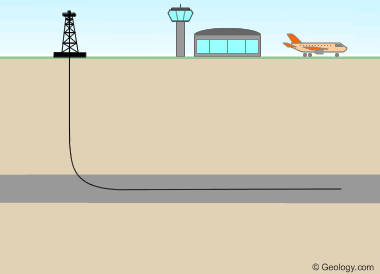
Horizontal Drilling Under an Airport: The Marcellus Shale underlies about 8,800 acres of land at the Pittsburgh International Airport, but operating drill rigs, maintaining active wellheads, and installing natural gas gathering lines are all prohibited activities on airport property. So, in 2013 Consol Energy proposed to produce natural gas from the Marcellus Shale by drilling 47 horizontal wells from 6 well pads located on adjacent lands. Over a 20-year period, Consol expects to pay the airport about $500 million in natural gas royalties. This is a perfect example of using horizontal drilling to reach an inaccessible target.
Table of Contents
What is Horizontal Drilling?
Most wells drilled for water, oil, natural gas, information or other subsurface objectives are vertical wells - drilled straight down into the earth. However, drilling horizontally or at an angle other than vertical can obtain information, hit targets, and stimulate reservoirs in ways that cannot be achieved with a vertical well. In these cases, an ability to accurately steer the well in directions and angles that depart from the vertical is a valuable ability.
When horizontal drilling is combined with hydraulic fracturing, some rock units which were unproductive when drilled vertically can become fantastic producers of oil or natural gas. Examples are the Marcellus Shale of the Appalachian Basin and the Bakken Formation of North Dakota.
| (B) Drain large areas from one drill pad |
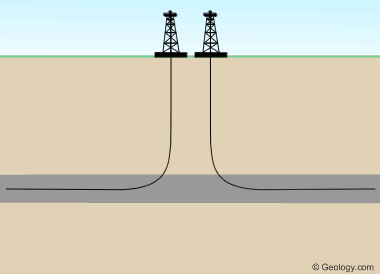
Minimize Footprint: One drilling pad can be used to drill a number of wells. This reduces the footprint of drilling operations. In 2010 the University of Texas at Arlington drilled 22 wells on a single platform. These wells are draining the natural gas from about 1100 acres beneath the campus. Over a 25-year lifetime, the wells are expected to produce a total of 110 billion cubic feet of natural gas. The alternative would be to drill many wells, each requiring a drilling pad, pond, access road and gathering line.
Why Drill Horizontal Wells?
Horizontal drilling has been used for many purposes, which include:
1) reach inaccessible targets2) drain large areas from one drill pad
3) increase the length of the "pay zone"
4) improve production in fractured reservoirs
5) construct relief wells
6) install utility service
These six purposes are described below and graphically illustrated by the six drawings on this page.
A) Hit targets that cannot be reached by vertical drilling.
Sometimes a reservoir is located under a city, airport, or park where drilling is impossible or forbidden. This reservoir might still be tapped if the drilling pad is located on the edge of the property and the well is drilled at an angle that will intersect the reservoir.
See graphic (A) - at the top of this page - to learn how the Pittsburgh International Airport will be paid $500 million for their gas.
B) Drain large areas from one drill pad.
This method has been used to reduce the surface footprint of a drilling operation. In 2010, the University of Texas at Arlington was featured in the news for drilling 22 wells on a single drill pad that will drain natural gas from 1100 acres beneath the campus.
Over a 25-year lifetime, the wells are expected to produce a total of 110 billion cubic feet of gas. This method significantly reduced the footprint of natural gas development within the campus area. See graphic (B) to learn more.
| (C) Increase the length of the "pay zone" |
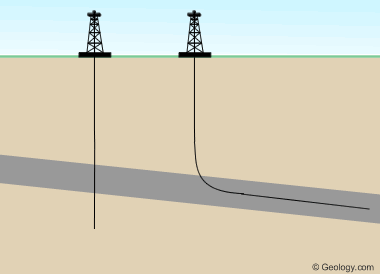
Maximize Pay Zone: If a vertical well is drilled through a 50-foot-thick reservoir rock, then natural gas or oil can seep into the well through 50 linear feet of "pay zone." However, if the well is turned to horizontal (or the same inclination as the rock unit) and drilled within that rock unit, then the distance of penetration within the pay zone can be much greater. Many horizontal wells in natural gas source rocks have over one mile of pay zone penetration.
C) Increase the length of the "pay zone" within the target rock unit.
If a rock unit is fifty feet thick, a vertical well drilled through it will have a pay zone that is fifty feet in length. However, if the well is turned and drilled horizontally through the rock unit for five thousand feet, then that single well will have a pay zone that is five thousand feet long.
This longer pay zone will usually result in a significant productivity increase for the well. When combined with hydraulic fracturing, horizontal drilling can convert unproductive shales into fantastic reservoir rocks.
| (D) Higher yield in fractured reservoirs |
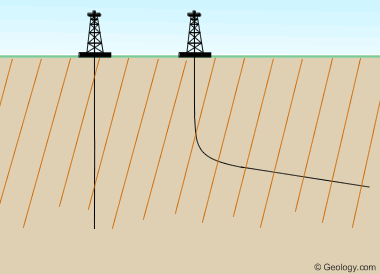
Fractured Reservoirs: Many subsurface rock units have "sets" of parallel fractures that are vertical or near-vertical. These fractures form naturally and can be an important route for the collection of fluids (water, natural gas, oil, geothermal fluids) held within the rock, and the movement of those fluids to wells or outcrops. In many geographic areas, there is a dominant fracture direction along which most of the fractures are aligned. If the well is drilled perpendicular to the plane of these fractures, then a maximum number of fractures will be penetrated.
D) Improve the productivity of wells in a fractured reservoir.
This is done by drilling in a direction that intersects a maximum number of fractures. The drilling direction will normally be at right angles to the dominant fracture direction.
Geothermal fields in granite bedrock usually get nearly all of their water exchange from fractures. Drilling at right angles to the dominant fracture direction will drive the well through a maximum number of fractures.
| (E) "Relief well" for an "out-of-control" well |

Relief Well: If a well has a problem and begins to flow out of control, it must be sealed at depth or the pressure must be relieved. In this situation a "relief well" can be drilled from a nearby site. The relief well will be a directionally drilled well that intersects the bore of the problem well to drain off some of the pressure or to plug the well by pumping cement into the bore.
E) Seal or relieve pressure in an "out-of-control" well.
If a producing well is out of control, a "relief well" can be drilled to intersect it. The intersecting well can be used to seal the original well or to relieve pressure in the out-of-control well.
F) Install underground utilities where excavation is not possible.
Horizontal drilling has been used to install gas and electric lines that must cross a river, cross a road, or travel under a city.
| (F) Installation of underground utilities |
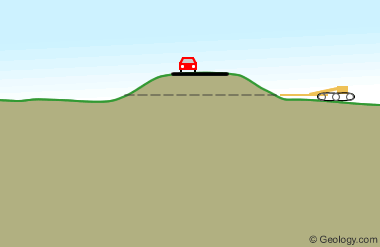
Utility Line: Utility service lines such as those delivering electricity, water, or natural gas are sometimes installed by directional drilling. This method is used when they must cross a road where excavation would disrupt traffic, cross a river where excavation is impossible, or transverse a community where surface installation by excavation would be extremely expensive and disrupting.
Candidate Rocks for Horizontal Drilling
Vertical wells can effectively drain rock units that have a very high permeability. Fluids in those rock units can flow quickly and efficiently into a well over long distances.
However, where permeability is very low, fluids move very slowly through the rock and do not travel long distances to reach a well bore. Horizontal drilling can increase the productivity in low-permeability rocks by bringing the well bore much closer to the source of the fluid.
Horizontal Drilling in Shales
Perhaps the most important role that horizontal drilling has played is in development of the natural gas shale plays. These low-permeability rock units contain significant amounts of gas and are present beneath very large parts of North America and other parts of the world. See our article on World Shale Gas Resources.
The Barnett Shale of Texas, the Fayetteville Shale of Arkansas, the Haynesville Shale of Louisiana and Texas, and the Marcellus Shale of the Appalachian Basin are examples. In these rock units the challenge is not "finding" the reservoir; the challenge is recovering the gas from very tiny pore spaces in a low-permeability rock unit.
To stimulate the productivity of wells in organic-rich shales, companies drill horizontally through the rock unit and then use hydraulic fracturing to produce artificial permeability that is propped open by frac sand. Done together, horizontal drilling and hydraulic fracturing can make a productive well where a vertical well would have produced only a small amount of gas.
Drilling Methodology
Most horizontal wells begin at the surface as a vertical well. Drilling progresses until the drill bit is a few hundred feet above the target rock unit. At that point the pipe is pulled from the well and a hydraulic motor is attached between the drill bit and the drill pipe.
The hydraulic motor is powered by a flow of drilling mud down the drill pipe. It can rotate the drill bit without rotating the entire length of drill pipe between the bit and the surface. This allows the bit to drill a path that deviates from the orientation of the drill pipe.
After the motor is installed, the bit and pipe are lowered back down the well, and the bit drills a path that steers the well bore from vertical to horizontal over a distance of a few hundred feet. Once the well has been steered to the proper angle, straight-ahead drilling resumes and the well follows the target rock unit. Keeping the well in a thin rock unit requires careful navigation. Downhole instruments are used to determine the azimuth and orientation of the drilling. This information is used to steer the drill bit.
Horizontal drilling is expensive. When combined with hydraulic fracturing, a well can cost up to three times as much per foot as drilling a vertical well. The extra cost is usually recovered by increased production from the well. These methods can multiply the yield of natural gas or oil from a well. Many profitable wells would be failures without these methods.
A New Lease and Royalty Philosophy?
In the production of gas from a vertical well, the gas is produced beneath a single parcel of property. Most states have long-established mineral rights rules that govern the ownership of gas produced from vertical wells. The gas is often shared by all landowners in a block of land or a radius distance from the producing well.
Horizontal wells introduce a new variable: a single well can penetrate and produce gas from multiple parcels with different owners. How can the royalties from this gas be fairly shared? This question is normally answered prior to drilling through a combination of government rules and private royalty-sharing agreements. How royalties are divided and how "hold-out" landowners are treated can be more complex than with a vertical well.
| More Oil |
 |
The Doorway to Hell |
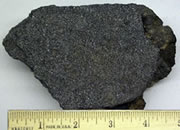 |
Oil Sands |
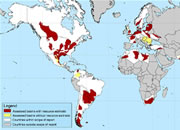 |
Shale Gas Resources |
 |
Gifts That Rock |
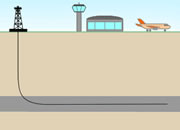 |
Horizontal Drilling |
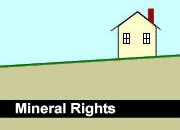 |
Oil and Gas Rights |
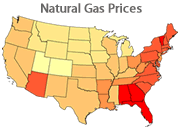 |
Natural Gas Prices |
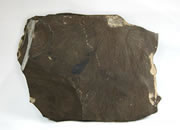 |
Oil Shale |

Find Other Topics on Geology.com:

|

| ||

|

| ||

|

| ||

|

|


